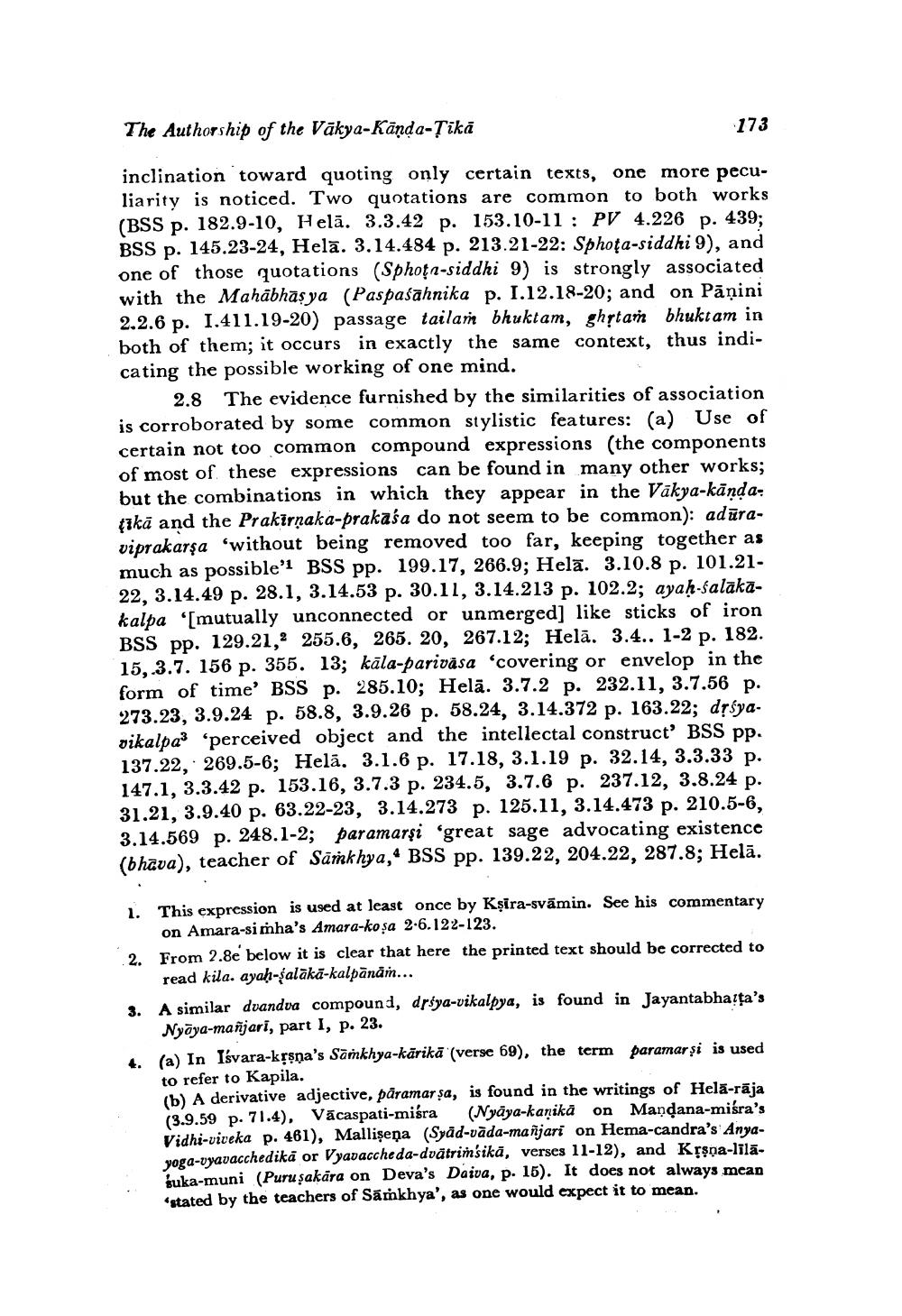Book Title: Authorship Of Vakya Kanda Tika Author(s): Ashok Aklujkar Publisher: Ashok Aklujkar View full book textPage 9
________________ The Authorship of the Vākya-Kānda-Tikā 173 inclination toward quoting only certain texts, one more peculiarity is noticed. Two quotations are common to both works (BSS p. 182.9-10, Helā. 3.3.42 p. 153.10-11 : PV 4.226 p. 439; BSS p. 145.23-24, Helā. 3.14.484 p. 213.21-22: Sphoța-siddhi 9), and one of those quotations (Sphoto-siddhi 9) is strongly associated with the Mahābhasya (Paspaśahnika p. 1.12.18-20; and on Pāṇini 2.2.6 p. 1.411.19-20) passage tailam bhuktam, ghrtam bhuktam in both of them; it occurs in exactly the same context, thus indicating the possible working of one mind. 2.8 The evidence furnished by the similarities of association is corroborated by some common stylistic features: (a) Use of certain not too common compound expressions (the components of most of these expressions can be found in many other works; but the combinations in which they appear in the Vākya-kānda. tikā and the Prakirņaka-prakaśa do not seem to be common): adūraviprakarşa 'without being removed too far, keeping together as much as possible'i BSS pp. 199.17, 266.9; Helā. 3.10.8 p. 101.2122, 3.14.49 p. 28.1, 3.14.53 p. 30.11, 3.14.213 p. 102.2; ayah-salakakalpa ‘[mutually unconnected or unmerged] like sticks of iron BSS pp. 129.21,2 255.6, 265. 20, 267.12; Helā. 3.4.. 1-2 p. 182. 15, 3.7. 156 p. 355. 13; kāla-parivasa 'covering or envelop in the form of time' BSS p. 285.10; Helā. 3.7.2 p. 232.11, 3.7.56 p. 273.23, 3.9.24 p. 58.8, 3.9.26 p. 58.24, 3.14.372 p. 163.22; drsyavikalpa: 'perceived object and the intellectal construct' BSS pp. 137.22, 269.5-6; Helā, 3.1.6 p. 17.18, 3.1.19 p. 32.14, 3.3.33 p. 147.1, 3.3.42 p. 153.16, 3.7.3 p. 234.5, 3.7.6 p. 237.12, 3.8.24 p. 31.21, 3.9.40 p. 63.22-23, 3.14.273 p. 125.11, 3.14.473 p. 210.5-6, 3.14.569 p. 248.1-2; paramarşi 'great sage advocating existence (bhava), teacher of Sākhya," BSS pp. 139.22, 204.22, 287.8; Helā. 1. This expression is used at least once by Kşira-svāmin. See his commentary on Amara-si mha's Amara-koşa 2.6.122-123. From 2.8e below it is clear that here the printed text should be corrected to read kila. ayah-salākā-kalpānam... 3. A similar dvandva compound, drsya-vikalpya, is found in Jayantabhaîța's Nyāya-mañjari, part I, p. 23. 4. (a) In Isvara-krsņa's Samkhya-kārikā (verse 69), the term paramarși is used to refer to Kapila. (b) A derivative adjective, pāramar şa, is found in the writings of Hela-rāja (3.9.59 p. 71.4), Vācaspati-miśra (Nyāya-kanikā on Mandana-misra's Vidhi-viveka p. 461), Mallişeņa (Syād-vāda-mañjari on Hema-candra's Anyayoga-vyavacchedikā or Vyavaccheda-dvätrinsikā, verses 11-12), and Krspa-lilasuka-muni (Puru şakāra on Deva's Daiva, p. 15). It does not always mean "stated by the teachers of Samkhya', as one would expect it to mean.Page Navigation
1 ... 7 8 9 10 11 12 13 14 15 16 17 18 19 20 21 22 23 24
